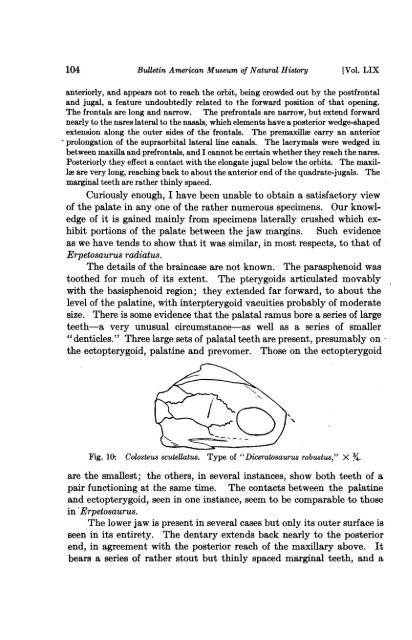View/Open - American Museum of Natural History
View/Open - American Museum of Natural History
View/Open - American Museum of Natural History
You also want an ePaper? Increase the reach of your titles
YUMPU automatically turns print PDFs into web optimized ePapers that Google loves.
104 Bulletin <strong>American</strong> <strong>Museum</strong> <strong>of</strong> <strong>Natural</strong> <strong>History</strong><br />
[Vol. LIX<br />
anteriorly, and appears not to reach the orbit, being crowded out by the postfrontal<br />
and jugal, a feature undoubtedly related to the forward position <strong>of</strong> that opening.<br />
The frontals are long and narrow. The prefrontals are narrow, but extend forward<br />
nearly to the nares lateral to the nasals, which elements have a posterior wedge-shaped<br />
extension along the outer sides <strong>of</strong> the frontals. The premaxillae carry an anterior<br />
prolongation <strong>of</strong> the supraorbital lateral line canals. The lacrymals were wedged in<br />
between maxilla and prefrontals, and I cannot be certain whether they reach the nares.<br />
Posteriorly they effect a contact with the elongate jugal below the orbits. The maxille<br />
are very long, reaching back to about the anterior end <strong>of</strong> the quadrate-jugals. The<br />
marginal teeth are rather thinly spaced.<br />
Curiously enough, I have been unable to obtain a satisfactory view<br />
<strong>of</strong> the palate in any one <strong>of</strong> the rather numerous specimens. Our knowledge<br />
<strong>of</strong> it is gained mainly from specimens laterally crushed which exhibit<br />
portions <strong>of</strong> the palate between the jaw margins. Such evidence<br />
as we have tends to show that it was similar, in most respects, to that <strong>of</strong><br />
Erpetosaurus radiatus.<br />
The details <strong>of</strong> the braincase are not known. The parasphenoid was<br />
toothed for much <strong>of</strong> its extent. The pterygoids articulated movably<br />
with the basisphenoid region; they extended far forward, to about the<br />
level <strong>of</strong> the palatine, with interpterygoid vacuities probably <strong>of</strong> moderate<br />
size. There is some evidence that the palatal ramus bore a series <strong>of</strong> large<br />
teeth-a very unusual circumstance-as well as a series <strong>of</strong> smaller<br />
" denticles. " Three large sets <strong>of</strong> palatal teeth are present, presumably on<br />
the ectopterygoid, palatine and prevomer. Those on the ectopterygoid<br />
Fig. 10.. Colosteus scutellatus. Type <strong>of</strong> "Diceratosaurus robustus," X Y.<br />
are the smallest; the others, in several instances, show both teeth <strong>of</strong> a<br />
pair functioning at the same time. The contacts between the palatine<br />
and ectopterygoid, seen in one instance, seem to be comparable to those<br />
in 'Erpetosaurus.<br />
The lower jaw is present in several cases but only its outer surface is<br />
seen in its entirety. The dentary extends back nearly to the posterior<br />
end, in agreement with the posterior reach <strong>of</strong> the maxillary above. It<br />
bears a series <strong>of</strong> rather stout but thinly spaced marginal teeth, and a
















